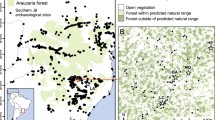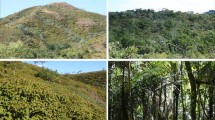Abstract
Recently we reported on the expansion of riparian forests into savannas in central Brazil. To enlarge the scope of the earlier study we investigated whether upland deciduous and xeromorphic forests behaved similarly. We investigated past vegetation changes that occurred in forest/savanna transitions using carbon isotope ratios (δ13C) measured in the soil organic matter as a tracer. We analyzed the 14C activity where δ13C showed major shifts in vegetation. The role of soil chemical and physical attributes in defining vegetation distribution is discussed. Structural changes in vegetation were found to be associated with shifts in the isotope composition (δ13C) of soil organic matter. This was attributed to intrinsic differences in the biomass of trees and grasses and allowed for the determination of past shifts in vegetation by evaluating δ13C at different depths. The deciduous forest decreased in area approximately 980 years ago. Tree cover increased in the xeromorphic forest, but the border stayed stable through time. The deciduous forest and adjacent savanna have eutrophic soils while the xeromorphic forest and adjacent savanna have dystrophic soils. However, greater organic carbon, nitrogen and phosphorus concentrations are observed in the forests. We provide concrete evidence of deciduous forest retreat unlike the stability observed in the xeromorphic forest/savanna boundary. These results contrast with the expansion of riparian forests recently reported in the same region.



Similar content being viewed by others
References
Balesdent J, Girarden C, Mariotti A (1993) Site-related d13C of tree leaves and soil organic matter in a temperate forest. Ecology 74:1713–1721
Benner R, Fogel ML, Sprague K, Hodson RE (1987) Depletion of 13C in lignin and its implications for stable carbon isotope studies. Nature 329:708–710
Behling H (2002) South and Southeast Brazilian grasslands during late Quaternary times: a synthesis. Palaeogeogr Palaeoclimatol Palaeoecol 177:19–27
Behling H, Pillar VP, Bauermann SG (2005) Late Quaternary grassland (Campos), gallery forest, fire and climate dynamics, studied by pollen, charcoal and multivariate analysis of the Sao Francisco de Assis core in western Rio Grande do Sul (southern Brazil). Rev Palaeobot Palynology 133:235–248
Bond WJ, Midgley GF, Woodward FI (2003) The importance of low atmospheric CO2 and fire in promoting the spread of grasslands and savannas. Global Change Biol 9:973–982
Boutton TW, Archer SR, Midwood AJ, Zitzer SF, Bol R (1998) δ13C values of soil organic carbon and their use in documenting vegetation change in a subtropical savanna ecosystem. Geoderma 82:5–41
Bremner JM, Mulvaney CS (1982) Nitrogen total. In: Page AL, Miller RH, Keeney DR (eds) Methods of soil analysis: chemical and microbiological properties vol. 2, 2nd edn. American Society of Agronomy, Madison, pp 595–624
Day PR (1965) Particle fractionation and particle-size analysis. In: Black CA (ed) Methods of soil analysis. American Society of Agronomy, Madison, pp 545–567
Dümig A, Schad P, Rumpel C, Dignac M, Kögel-Knabner I (2008) Araucaria forest expansion on grassland in the southern Brazilian highlands as revealed by 14C and δ13C studies. Geoderma 145:143–147
Durigan G, Ratter JA (2006) Successional changes in cerrado and cerrado/forest ecotonal vegetation in western Sao Paulo State, Brazil, 1962–2000. Edinburgh J Bot 63:119–130
Ehleringer JR, Cerling TE, Helliker BR (1997) C4 photosynthesis, atmospheric CO2 and climate. Oecologia 112:285–299
Ehleringer JR, Buchmann N, Flanagan LB (2000) Carbon isotope ratios in belowground carbon cycle processes. Ecol Appl 10:412–422
Eiten G (1972) The cerrado vegetation of central Brazil. Bot Rev 38:201–341
EMBRAPA (1978) Levantamento de reconhecimento dos solos do Distrito Federal. Boletim Técnico, no. 53, Serviço Nacional de Levantamento e Conservação de Solos. Rio de Janeiro
Farquhar GD, O’Leary MH, Berry JA (1982) On the relationship between carbon isotope discrimination and the inter-cellular carbon-dioxide concentration in leaves. Aust J Plant Physiol 9:121–137
Felfili JM, Nascimento ART, Fagg CW, Meirelles EM (2007) Floristic composition and community structure of a seasonally deciduous forest on limestone outcrops in Central Brazil. Rev Bras Bot 30:611–621
Franco AC, Bustamante M, Caldas LS, Goldstein G, Meinzer FC, Kozovits AR, Rundel P, Coradin VTR (2005) Leaf functional traits of neotropical savanna trees in relation to seasonal water deficit. Trees 129:326–335
Funk J, Vitousek PM (2007) Resource use efficiency and plant invasion in low-resource systems. Nature 446:1078–1081
Furley PA (1992) Nature and dynamics of forest-savanna boundaries. Chapman and Hall, London
Furley PA (1999) The nature and diversity of neotropical savanna vegetation with particular reference to the Brazilian cerradões. Global Ecol Biogeogr 8:223–241
Furley PA (2007) Tropical savannas and associated forests: vegetation and plant ecology. Prog Phys Geogr 31:203–211
Furley PA, Grace J, Meir P (2006) Tropical savannas and seasonally dry forests: vegetation and environment. Special issue. J Biogeogr 33:164
Goedert WJ, Schermack MJ, Freitas FC (2002) Estado de compactação do solo em áreas cultivadas no sistema de plantio direto. Pesq Agropec Bras 37:233–227
Goodland R (1971) A physiognomic analysis of the “cerrado” vegetation of Central Brasil. J Ecol 59:411–419
Haidar RF (2007) Fitossociologia, diversidade e sua relação com variáveis ambientais em florestas estacionais do bioma Cerrado no planalto central e nordeste do Brasil. Universidade de Brasília, Dissertation
Haridasan M (1992) Observations on soils, foliar nutrient concentrations and floristic composition of cerradão sensu stricto and cerradão communities in central Brazil. In: Furley PA, Proctor J, Ratter JA (eds) Nature and dynamics of forest-savanna boundaries. Chapman and Hall, London, pp 171–184
Haridasan M (2001) Nutrient cycling as a function of landscape and biotic characteristics in the cerrado of central Brazil. In: McClain ME, Victoria RL, Richey JE (eds) Biogeochemistry of the amazon basin and its role in a changing world. Oxford University Press, New York, pp 68–83
Hoffmann WA, Silva ER, da Machado GC, Bucci SJ, Scholz FG, Goldstein G, Meinzer FC (2005) Seasonal leaf dynamics across a tree density gradient in a Brazilian savanna. Oecologia 145:307–316
Klink CA, Joly CA (1989) Identification and distribution of C3 and C4 grasses in open and shaded habitats in Sao Paulo state, Brazil. Biotropica 21:30–34
Krull ES, Bestland EA, Gates WP (2002) Soil organic matter decomposition and turnover in a tropical ultisol: evidence from δ13C, δ15N and geochemistry. Radiocarbon 44:93–112
Ledru MP (1992) Late Quaternary environmental and climatic changes in central Brazil. Quatern Res 39:90–98
Lisi CS, Tomazello M, Botoss PC, Roig FA, Maria VRB, Ferreira-Fedele L, Voigt ARA (2008) Tree-ring formation, radial increment periodicity, and phenology of tree species from a seasonal semi-deciduous forest in southeast Brazil. Iawa J 29:189–207
Marimon BH, Haridasan M (2005) Comparação da vegetação arbórea e características edáficas de um cerradão e um cerrado sensu stricto em áreas adjacentes sobre solo distrófico no leste de Mato Grosso. Acta Bot Bras 19:913–926
Marino BD, McElroy MB, Salawitch RJ, Spaulding WG (1992) Glacial-to-interglacial variations in the carbon isotopic composition of atmospheric CO2. Nature 357:461–466
Martinelli LA, Pessenda LCR, Espinoza E (1996) Carbon-13 depth variation in soil of Brazil and relations with climate changes during the Quaternary. Oecologia 106:376–381
Mayle F (2006) The Late Quaternary biogeographical history of South American seasonally dry tropical forests: insights from palaeo-ecological data. In: Pennington T, Lewis GP, Ratter JA (eds) Neotropical savannas and seasonally dry forests. Systematics Association, CRC-Taylor and Francis, pp 395–416
Mehlich A (1953) Determination of P, Ca, Mg, K, Na and NH4. North Carolina Soil Test Division, North Carolina Department of Agriculture, Raleigh
Mendonça RC, Felfili JM, Walter BMT, Silva-Júnior MC, Rezende AV, Filgueira T, Nogueira PE (1998) A flora vascular do cerrado. In: Sano SM, Almeida SP (eds) Cerrado ambiente e flora. EMBRAPA, Planaltina, pp 279–556
Miles L, Newton AC, DeFries RS, Ravilious C, May I, Kapos V, Gordon JL (2006) A global overview of the conservation status of tropical dry forests. J Biogeogr 33:491–505
Netto PB, Mecenas VV, Cardoso ES (2005) APA de Cafuringa: a última fronteira natural do DF. Secretaria do Meio Ambiente e Recursos Hídricos
Oliveira-Filho AT, Shepherd GJ, Martins FR, Stubblebine WH (1989) Environmental factors affecting physiognomical and floristic variation in a Cerrado of Central Brazil. J Trop Ecol 5:413–431
Oliveira-Filho AT, Ratter JA (2002) Vegetation physiognomies and woody flora of the Cerrado Biome. In: Oliveira PS, Marquis RJ (eds) The Cerrados of Brazil: ecology and natural history of a Neotropical savanna. Columbia University Press, New York, pp 91–120
Palmer AR, Van Rooyen AF (1998) Detecting vegetation change in the southern Kalahari using Landsat TM data. J Arid Environ 3:143–153
Pennington RT, Prado DE, Pendry CA (2000) Neotropical seasonally dry forests and quaternary vegetation changes. J Biogeogr 27:261–273
Pennington RT, Lavin M, Prado DE, Pendry CA, Pell S, Butterworth CA (2004) Historical climate change and speciation: neotropical seasonally dry forest plants show patterns of both Tertiary and Quaternary diversification. Philos Trans R Soc 359:515–538
Pennington T, Lewis G, Ratter JA (2006) Neotropical savannas and seasonally dry forests: plant diversity, biogeography, and conservation. Systematics association, special volume series 69. CRC-Taylor and Francis, Boca Raton
Puyravaud JP, Pascal JP, Dufour C (1994) Ecotone structure as an indicator of changing forest-savanna boundaries (Linganamakki Region, southern India). J Biogeogr 21:581–593
Reatto A, Martins ES, Farias MFR, Silva AV, Carvalho Junior OA (2004) Mapa pedológico digital—SIG atualizado do Distrito Federal Escala 1: 100.000 e uma síntese do texto explicativo. EMBRAPA Cerrados, Planaltina
Ribeiro JF, Silva JCS, Batmanian GJ (1985) Fitossociologia de tipos fisionômicos de cerrado em Planaltina, DF. Rev Bras Bot 8:131–142
Ribeiro JF, Walter BMT (1998) Fitofisionomias do Bioma Cerrado. In: Sano S, Almeida S (eds) Cerrado: ambiente e flora. EMBRAPA Cerrados, Brasília, pp 89–166
Ruggiero PGC, Batalha MA, Pivello VR, Meiralles ST (2002) Soil-vegetation relationships in cerrado (Brazilian savanna) and semideciduous forest, Southeastern Brazil. Plant Ecol 160:1–16
Sanaiotti TM, Martinelli LA, Victoria RL, Trumbore SE, Camargo PB (2002) Past vegetation changes in Amazon savannas determined using carbon isotopes of soil organic matter. Biotropica 34:2–16
Silva LCR, Sternberg L, Haridasan M, Hoffmann WA, Miralles-Wilhelm F, Franco AC (2008) Expansion of gallery forests into central Brazilian savannas. Global Change Biol 14:1–11
Silva LCR, Anand M, Oliveira JM, Pillar VD (2009) Past century changes in Araucaria angustifolia (Bertol.) Kuntze water use efficiency and growth in forest and grassland ecosystems of southern Brazil: implications for forest expansion. Glob Chang Biol 5:2387–2396
Smith BN, Epstein S (1971) Two categories of 13C/12C ratios for higher plants. Plant Physiol 47:380–394
Vitousek P, Matson P (1984) Mechanisms of nitrogen retention in forest ecosystems: a field experiment. Science 225:51–52
Vourlitis GL, Priante Filho N, Hayashi MMS, Nogueira JS, Caseiro FT, Holanda-Campelo J (2001) Seasonal variations in the net ecosystem CO2 exchange of a mature Amazonian transitional tropical forest (cerradão). Funct Ecol 15:388–395
Waibel L (1948) Vegetation and land use in the planalto central of Brazil. Geogr Rev 38:529–554
Walkley A, Black IA (1934) An examination of the Degtjareff method for determining soil organic matter and a proposed modification of the chromic acid titration method. Soil Sci 37:29–38
Williams JW, Shuman BN, WebbIII T, Bartlein PJ, Leduc PL (2004) Late-quaternary vegetation dynamics in north America: scaling from taxa to biome. Ecol Monogr 74:309–334
Acknowledgements
We thank Jose´ Carlos Sousa Silva at EMBRAPA Cerrados and Ricardo Flores Haidar, Gabriel Damasco do Vale and Regina Kruse for field assistance and valuable comments. This research is based upon work supported by the National Science Foundation Grant No. DEB-0542912 (W. H.), AW Mellon Foundation (W. H.) and National Science Foundation Grant No. EAR-BE-332051.
Author information
Authors and Affiliations
Corresponding author
Additional information
Responsible Editor: Tibor Kalapos.
Rights and permissions
About this article
Cite this article
Silva, L.C.R., Haridasan, M., Sternberg, L.S.L. et al. Not all forests are expanding over central Brazilian savannas. Plant Soil 333, 431–442 (2010). https://doi.org/10.1007/s11104-010-0358-6
Received:
Accepted:
Published:
Issue Date:
DOI: https://doi.org/10.1007/s11104-010-0358-6




